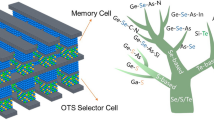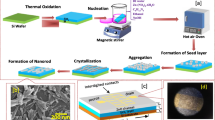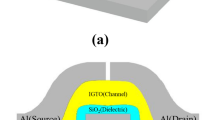Abstract
The growth of titanium nitride (TiN) thin films with bulk TiN conductivity for inert electrode applications remains a challenge, owing to various microstructural and compositional properties. Here, we report the fabrication of TiN thin films using optimised RF magnetron sputtering, where deposition conditions were tailored to achieve metal like electrical conductivity in TiN films. The TiN thin films deposited at 750 °C and in pure nitrogen ambient, revealed the minimum resistivity of ~ 26 µΩ cm, matching bulk TiN and suitable for electrode applications. The TiN thin films were used as bottom electrode to fabricate Cu/TiO2/TiN devices, which demonstrated repeatable non-volatile bipolar resistive switching characteristics with good endurance, retention, and multibit capability. The resistive switching and current conduction mechanisms of the device were explained considering Cu atom constituting filamentary switching, caused due to electrochemical metallization. The switching parameters and mechanism of TiO2 based devices using TiN bottom electrode were found to be similar to those observed in Pt based RRAM devices, demonstrating TiN films’ capability as an effective substitute for noble metal electrodes. This study may aid in the development of device grade metal like conducting TiN thin films, which are potential alternate to noble metal electrodes for resistive switching memory applications.









Similar content being viewed by others
Data availability
All data generated during this study are included in this article or in supplementary information files, if any.
References
Q. Xie et al., Improvement of microstructure and tribological properties of titanium nitride films by optimization of substrate bias current. Thin Solid Films 749, 139181 (2022). https://doi.org/10.1016/j.tsf.2022.139181
A. Ghailane et al., Titanium nitride, TiXN(1–X), coatings deposited by HiPIMS for corrosion resistance and wear protection properties. Appl. Surf. Sci. 574, 151635 (2022). https://doi.org/10.1016/j.apsusc.2021.151635
R. Gao et al., Epitaxial titanium nitride microwave resonators: structural, chemical, electrical, and microwave properties. Phys. Rev. Mater. 6(3), 036202 (2022). https://doi.org/10.1103/PhysRevMaterials.6.036202
P. Patsalas, N. Kalfagiannis, S. Kassavetis, Optical properties and plasmonic performance of titanium nitride. Materials (2015). https://doi.org/10.3390/ma8063128
N. Yokoyama, K. Hinode, Y. Homma, LPCVD titanium nitride for ULSIs. J. Electrochem. Soc. 138(1), 190 (1991). https://doi.org/10.1149/1.2085535
M.C. Lemme et al., Nanoscale TiN metal gate technology for CMOS integration. Microelectron. Eng. 83(4), 1551–1554 (2006). https://doi.org/10.1016/j.mee.2006.01.161
L. Wang et al., Effect of residual gas on structural, electrical and mechanical properties of niobium films deposited by magnetron sputtering deposition. Mater. Res. Express 5(4), 046410 (2018). https://doi.org/10.1088/2053-1591/aab8c1
R. Banerjee, R. Chandra, P. Ayyub, Influence of the sputtering gas on the preferred orientation of nanocrystalline titanium nitride thin films. Thin Solid Films 405(1), 64–72 (2002). https://doi.org/10.1016/S0040-6090(01)01705-9
J. Yang et al., TiN films fabricated by reactive gas pulse sputtering: a hybrid design of multilayered and compositionally graded structures. Appl. Surf. Sci. 389, 255–259 (2016). https://doi.org/10.1016/j.apsusc.2016.07.062
A. Kehal, N. Saoula, S.-E.-H. Abaidia, C. Nouveau, Effect of Ar/N2 flow ratio on the microstructure and mechanical properties of Ti-Cr-N coatings deposited by DC magnetron sputtering on AISI D2 tool steels. Surf. Coat. Technol. 421, 127444 (2021). https://doi.org/10.1016/j.surfcoat.2021.127444
H. Guo, W. Chen, Y. Shan, W. Wang, Z. Zhang, J. Jia, Microstructures and properties of titanium nitride films prepared by pulsed laser deposition at different substrate temperature. Appl. Surf. Sci. 357, 473–478 (2015). https://doi.org/10.1016/j.apsusc.2015.09.061
G. Sjoblom, J. Westlinder, J. Olsson, Investigation of the thermal stability of reactively sputter-deposited TiN MOS gate electrodes. IEEE Trans. Electron Devices 52(10), 2349–2352 (2005). https://doi.org/10.1109/TED.2005.856796
F. Vaz et al., Influence of nitrogen content on the structural, mechanical and electrical properties of TiN thin films. Surf. Coat. Technol. 191(2), 317–323 (2005). https://doi.org/10.1016/j.surfcoat.2004.01.033
H. von Seefeld, N.W. Cheung, M. Maenpaa, M.-A. Nicolet, Investigation of titanium-nitride layers for solar-cell contacts. IEEE Trans. Electron Devices 27(4), 873-876, (1980). https://doi.org/10.1109/T-ED.1980.19949
N.K. Ponon et al., Effect of deposition conditions and post deposition anneal on reactively sputtered titanium nitride thin films. Thin Solid Films 578, 31–37 (2015). https://doi.org/10.1016/j.tsf.2015.02.009
F.-H. Lu, J.-L. Lo, The influences of oxygen impurity contained in nitrogen gas on the annealing of titanium nitride. J. Eur. Ceram. Soc. 22(8), 1367–1374 (2002). https://doi.org/10.1016/S0955-2219(01)00444-7
L. Hultman, J.-E. Sundgren, L.C. Markert, J.E. Greene, Ar and excess N incorporation in epitaxial TiN films grown by reactive bias sputtering in mixed Ar/N2 and pure N2 discharges. J. Vac. Sci. Technol. A 7(3), 1187–1193 (1989). https://doi.org/10.1116/1.576251
N.D. Cuong, D.-J. Kim, B.-D. Kang, S.-G. Yoon, Effects of nitrogen concentration on structural and electrical properties of titanium nitride for thin-film resistor applications. Electrochem. Solid State Lett. (2006). https://doi.org/10.1149/1.2216592
P. Gu, X. Zhu, J. Li, H. Wu, D. Yang, Influence of substrate and Ar/N2 gas flow ratio on structural, optical and electrical properties of TiN thin films synthetized by DC magnetron sputtering. J. Mater. Sci. Mater. Electron. 29(12), 9893–9900 (2018). https://doi.org/10.1007/s10854-018-9031-2
V.K. Sahu, A.K. Das, R.S. Ajimsha, P. Misra, Low power high speed 3-bit multilevel resistive switching in TiO2 thin film using oxidisable electrode. J. Phys. Appl. Phys, 53(22), 225303 (2020). https://doi.org/10.1088/1361-6463/ab7acb
G. Greczynski, L. Hultman, A step-by-step guide to perform x-ray photoelectron spectroscopy. J. Appl. Phys. 132(1), 011101 (2022). https://doi.org/10.1063/5.0086359
I. Milosv, H.-H. Strehblow, B. Navinsek, M. Metikos-Hukovic, Electrochemical and thermal oxidation of TiN coatings studied by XPS. Surf. Interface Anal. 23(7–8), 529–539 (1995). https://doi.org/10.1002/sia.740230713
H.-Y. Chen, F.-H. Lu, Oxidation behavior of titanium nitride films. J. Vac. Sci. Technol. Vac. Surf. Films 23(4), 1006–1009 (2005). https://doi.org/10.1116/1.1914815
R. Chowdhury, R.D. Vispute, K. Jagannadham, J. Narayan, Characteristics of titanium nitride films grown by pulsed laser deposition. J. Mater. Res. 11(6), 1458–1469 (1996). https://doi.org/10.1557/JMR.1996.0182
G. Martinez, V. Shutthanandan, S. Thevuthasan, J.F. Chessa, C.V. Ramana, Effect of thickness on the structure, composition and properties of titanium nitride nano-coatings. Ceram. Int. 40(4), 5757–5764 (2014). https://doi.org/10.1016/j.ceramint.2013.11.014
M. Benegra, D.G. Lamas, M.E. Fernández de Rapp, N. Mingolo, A.O. Kunrath, R.M. Souza, Residual stresses in titanium nitride thin films deposited by direct current and pulsed direct current unbalanced magnetron sputtering. Thin Solid Films 494(1), 146–150 (2006). https://doi.org/10.1016/j.tsf.2005.08.214
M. Dopita, D. Rafaja, X-ray residual stress measurement in titanium nitride thin films. Ninth European Powder Diffraction Conference: Prague, September 2-5, 2004 (München: Oldenbourg Wissenschaftsverlag, 2006), pp. 67–72. https://doi.org/10.1524/9783486992526-014
H. Ju et al., Enhancement on the hardness and oxidation resistance property of TiN/Ag composite films for high temperature applications by addition of Si. Vacuum 209, 111752 (2023). https://doi.org/10.1016/j.vacuum.2022.111752
H. Oettel, R. Wiedemann, S. Preißler, Residual stresses in nitride hard coatings prepared by magnetron sputtering and arc evaporation. Surf. Coat. Technol. (1995). https://doi.org/10.1016/0257-8972(95)08235-2
K. He, N. Chen, C. Wang, L. Wei, J. Chen, Method for determining crystal grain size by X-ray diffraction. Cryst. Res. Technol. 53(2), 1700157 (2018). https://doi.org/10.1002/crat.201700157
L. Braic et al., Titanium oxynitride thin films with tunable double epsilon-near-zero behavior for nanophotonic applications. ACS Appl. Mater. Interfaces 9(35), 29857–29862 (2017). https://doi.org/10.1021/acsami.7b07660
M.N. Solovan, V.V. Brus, E.V. Maistruk, P.D. Maryanchuk, Electrical and optical properties of TiN thin films. Inorg. Mater. 50(1), 40–45 (2014). https://doi.org/10.1134/S0020168514010178
C. Foo et al., Characterisation of oxygen defects and nitrogen impurities in TiO2 photocatalysts using variable-temperature X-ray powder diffraction. Nat. Commun. 12(1), 1 (2021). https://doi.org/10.1038/s41467-021-20977-z
S. Kumar, M. Das, M.T. Htay, S. Sriram, S. Mukherjee, Electroforming-free, Y2O3 memristive crossbar array with low variability. ACS Appl. Electron. Mater. 4(6), 3080–3087 (2022). https://doi.org/10.1021/acsaelm.2c00472
Y. Li et al., Improved resistive switching uniformity of SiO2 electrolyte-based resistive random access memory device with Cu oxidizable electrode. IEEE Electron Device Lett. 40(10), 1599–1601 (2019). https://doi.org/10.1109/LED.2019.2934145
M.C. Sahu et al., Reconfigurable low-power TiO2 memristor for integration of artificial synapse and nociceptor. ACS Appl. Mater. Interfaces 15, 25713–25725 (2023). https://doi.org/10.1021/acsami.3c02727
M. Zhang et al., Analysis on the filament structure evolution in reset transition of Cu/HfO2/Pt RRAM device. Nanoscale Res. Lett. 11(1), 269 (2016). https://doi.org/10.1186/s11671-016-1484-8
D.-H. Lim et al., Electric field effect dominated bipolar resistive switching through interface control in a Pt/TiO2 /TiN structure. RSC Adv. 5(1), 221–230 (2015). https://doi.org/10.1039/C4RA09443C
H. Jeon et al., Resistive switching behaviors of Cu/TaOx/TiN device with combined oxygen vacancy/copper conductive filaments. Curr. Appl. Phys. 15(9), 1005–1009 (2015). https://doi.org/10.1016/j.cap.2015.06.002
S. Kumar, A. Agarwal, S. Mukherjee, Electrical performance of large-area Y2O3 memristive crossbar array with ultralow C2C variability. IEEE Trans. Electron Devices 69(7), 3660–3666 (2022). https://doi.org/10.1109/TED.2022.3172400
A.K. Jena et al., Bipolar resistive switching in TiO2 artificial synapse mimicking Pavlov’s associative learning. ACS Appl. Mater. Interfaces 15(2), 3574–3585 (2023). https://doi.org/10.1021/acsami.2c17228
M.C. Sahu, S.K. Mallik, S. Sahoo, S.K. Gupta, R. Ahuja, S. Sahoo, Effect of charge injection on the conducting filament of valence change anatase TiO2 resistive random access memory device. J. Phys. Chem. Lett. 12(7), 1876–1884 (2021). https://doi.org/10.1021/acs.jpclett.1c00121
I. Valov, R. Waser, J.R. Jameson, M.N. Kozicki, Electrochemical metallization memories—fundamentals, applications, prospects. Nanotechnology 22(25), 254003 (2011). https://doi.org/10.1088/0957-4484/22/25/254003
M. Dutta, A. Senapati, S. Ginnaram, S. Maikap, Resistive switching memory and artificial synapse by using Ti/MoS2 based conductive bridging cross-points. Vacuum 176, 109326 (2020). https://doi.org/10.1016/j.vacuum.2020.109326
Y. Tian, L. Jiang, X. Zhang, G. Zhang, Q. Zhu, Trap-assisted transition between Schottky emission and Fowler-Nordheim tunneling in the interfacial-memristor based on Bi2S3 nano-networks. AIP Adv. 8(3), 035105 (2018). https://doi.org/10.1063/1.5006433
C. Hu, M.D. McDaniel, A. Posadas, A.A. Demkov, J.G. Ekerdt, E.T. Yu, Highly controllable and stable quantized conductance and resistive switching mechanism in single-crystal TiO2 resistive memory on silicon. Nano Lett. 14(8), 4360–4367 (2014). https://doi.org/10.1021/nl501249q
Y. Li, Z. Wang, R. Midya, Q. Xia, J.J. Yang, Review of memristor devices in neuromorphic computing: materials sciences and device challenges. J. Phys. Appl. Phys. 51(50), 503002 (2018). https://doi.org/10.1088/1361-6463/aade3f
V.K. Sahu, A.K. Das, R.S. Ajimsha, P. Misra, On origin of resistive and capacitive contributions to impedance of memory states in Cu/TiO2/Pt RRAM devices by impedance spectroscopy. Ceram. Int. 49(2), 2215–2223 (2023). https://doi.org/10.1016/j.ceramint.2022.09.188
Acknowledgements
The authors would like to thank Shri R. Kaul, Associate Director, Materials Science and Advanced Technology Group, and Head, Laser Materials Processing Division, RRCAT for his keen interest and helpful discussions.
Funding
The authors declare that no funds, grants, or other support were received during the preparation of this manuscript.
Author information
Authors and Affiliations
Contributions
Conceptualization: VKS, PM; Methodology: VKS, PM; Formal analysis and investigation: VKS, AKD, RSA, SB, RS, UD, SKR, and PM; Writing—original draft preparation: VKS; Writing—review and editing: VKS, AKD, RSA, SB, RS, UD, SKR, and PM; Resources: RSA; Supervision: PM.
Corresponding author
Ethics declarations
Competing interest
The authors have no relevant financial or non-financial interests to disclose.
Additional information
Publisher’s Note
Springer Nature remains neutral with regard to jurisdictional claims in published maps and institutional affiliations.
Supplementary Information
Below is the link to the electronic supplementary material.
Rights and permissions
Springer Nature or its licensor (e.g. a society or other partner) holds exclusive rights to this article under a publishing agreement with the author(s) or other rightsholder(s); author self-archiving of the accepted manuscript version of this article is solely governed by the terms of such publishing agreement and applicable law.
About this article
Cite this article
Sahu, V.K., Das, A.K., Ajimsha, R.S. et al. Investigations on RF sputtered TiN thin films and Cu/TiO2/TiN devices for resistive switching memory applications. J Mater Sci: Mater Electron 34, 1818 (2023). https://doi.org/10.1007/s10854-023-11235-7
Received:
Accepted:
Published:
DOI: https://doi.org/10.1007/s10854-023-11235-7




